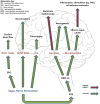Vagus nerve stimulation in ischemic stroke: old wine in a new bottle
- PMID: 25009531
- PMCID: PMC4067569
- DOI: 10.3389/fneur.2014.00107
Vagus nerve stimulation in ischemic stroke: old wine in a new bottle
Abstract
Vagus nerve stimulation (VNS) is currently Food and Drug Administration-approved for treatment of both medically refractory partial-onset seizures and severe, recurrent refractory depression, which has failed to respond to medical interventions. Because of its ability to regulate mechanisms well-studied in neuroscience, such as norepinephrine and serotonin release, the vagus nerve may play an important role in regulating cerebral blood flow, edema, inflammation, glutamate excitotoxicity, and neurotrophic processes. There is strong evidence that these same processes are important in stroke pathophysiology. We reviewed the literature for the role of VNS in improving ischemic stroke outcomes by performing a systematic search for publications in Medline (1966-2014) with keywords "VNS AND stroke" in subject headings and key words with no language restrictions. Of the 73 publications retrieved, we identified 7 studies from 3 different research groups that met our final inclusion criteria of research studies addressing the role of VNS in ischemic stroke. Results from these studies suggest that VNS has promising efficacy in reducing stroke volume and attenuating neurological deficits in ischemic stroke models. Given the lack of success in Phase III trials for stroke neuroprotection, it is important to develop new therapies targeting different neuroprotective pathways. Further studies of the possible role of VNS, through normally physiologically active mechanisms, in ischemic stroke therapeutics should be conducted in both animal models and clinical studies. In addition, recent advent of a non-invasive, transcutaneous VNS could provide the potential for easier clinical translation.
Keywords: cerebral blood flow; glutamate excitotoxicity; middle cerebral artery occlusion; neuroinflammation; stroke.
Figures



References
-
- Bailey P, Bremmer FA. A sensory cortical representation of the vagus nerve with a note on the low pressure on the surface electrogram. J Neurophysiol (1938) 1:404–12
-
- Dell P, Olson R. Thalamic, cortical and cerebellar projections of vagal visceral afferences. C R Seances Soc Biol Fil (1951) 145:1084–8 - PubMed
Publication types
LinkOut - more resources
Full Text Sources
Other Literature Sources
Miscellaneous

